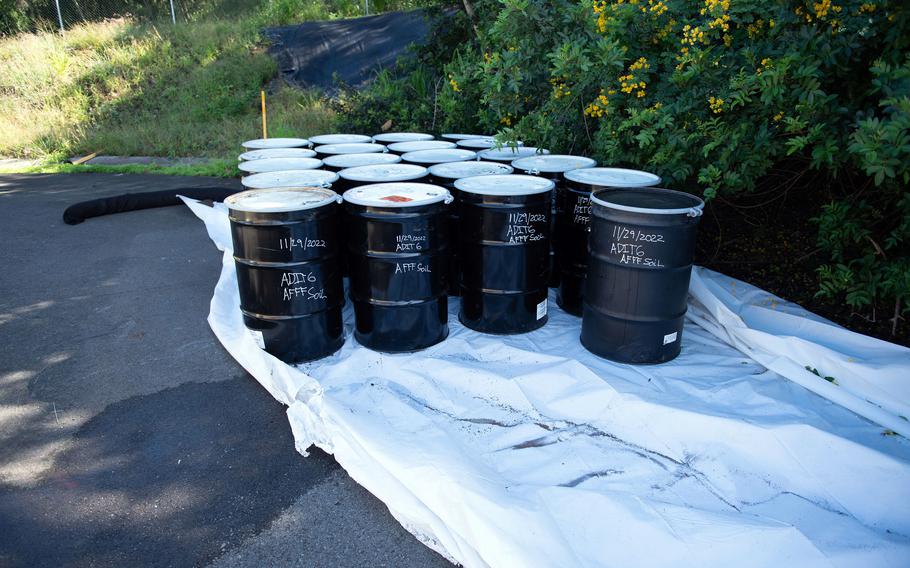
Drums for contaminated soil stand at the temporary staging area used for cleanup of toxic firefighting foam at the Red Hill fuel storage facility on the outskirts of Honolulu, Hawaii, Wednesday, Nov. 30, 2022. (U.S. Navy)
(Tribune News Service) — Approximately 1,500 gallons of concentrated firefighting suppressant containing toxic chemicals spilled at the Navy’s Red Hill underground fuel facility on Dec. 7, 2019, the Navy disclosed to regulators this week, bringing the number of known spills at the facility to three and elevating concerns that dangerous chemicals, called PFAS, still may be lurking in the environment as a result.
The fire suppressant, called aqueous film-forming foam, or AFFF, is used to suppress fires caused by flammable liquids such as fuel but also poses its own risks. The foam contains PFAS, referred to as “forever chemicals“ because they degrade so slowly in the environment. The chemicals have been linked to a higher risk of kidney and testicular cancer, increased risk of high blood pressure in pregnant women and immune disruption, among other health problems.
The Environmental Protection Agency has grown so concerned about PFAS that this week it proposed the first federal limits on the chemicals in drinking water, limiting them to the lowest possible level that tests can detect.
The 2019 spill at Red Hill was disclosed by the Navy this week as part of an extensive request for information from the EPA for details about past releases of AFFF at the beleaguered facility. The agency’s law enforcement arm requested the information after the Navy announced that on Nov. 29, 1, 300 gallons of AFFF concentrate had spilled at Red Hill. The spill, which a top state Department of Health official at the time called “egregious,“ sparked worries that the toxic chemicals could find their way into the groundwater.
The Navy has since conducted extensive remediation and testing at the site of 2022’s spill, where workers donning hazmat suits dug up soil, storing it in more than 130 55-gallon drums, and sopped up the fluid with absorbent pads. The work has been overseen by DOH and EPA officials, and follow-up tests at the site have indicated that the Navy was successful in quickly containing the spill.
It was not clear late Thursday what steps were taken to clean up the 2019 AFFF spill at Red Hill or whether state and federal regulators had been alerted at the time.
The EPA, as part of its information request that was due Wednesday, required the Navy to describe all known releases of AFFF at Red Hill, as well as any other spills of material that contained PFAS, the amounts, the circumstances that led to the releases, maps that showed the contaminated areas and any associated PFAS monitoring data. The Navy was also required to detail its efforts to clean up the spills, including how material was stored, treated and disposed of, and provide photographic evidence of remediation.
The EPA says the Navy turned over the requested information by Wednesday’s deadline, but officials say it’s still being reviewed to determine whether portions need to be redacted for security reasons before releasing it publicly.
The Navy, in response to queries from the Honolulu Star-Advertiser, provided a few pages of documents that list the 2019 spill but provide no other details other than that it was caused by a “system malfunction in building 1721 “ and that “response /repair actions “ were completed. No further details about what those actions were, or where exactly the release occurred at the Red Hill facility, were available late Thursday, according to a Navy spokesperson.
The document also lists another spill of approximately 5, 000 gallons of “AFFF-impacted water “ that was released in an underground pump house on Sept. 29, which was first reported by Honolulu Civil Beat in December based on information provided by a former Red Hill employee. The Navy told the Star-Advertiser following that report that water had been discharged through piping that previously held AFFF and that the liquid had been captured and placed in tanks. The Navy said that there had been no requirements at that time to report the spill to DOH.
A Navy spokesperson said the Navy is still reviewing documents to determine whether there were other spills at Red Hill, an inquiry that it has extended to all of Joint Base Pearl Harbor-Hickam.
(c)2023 The Honolulu Star-Advertiser
Visit The Honolulu Star-Advertiser at www.staradvertiser.com
Distributed by Tribune Content Agency, LLC.